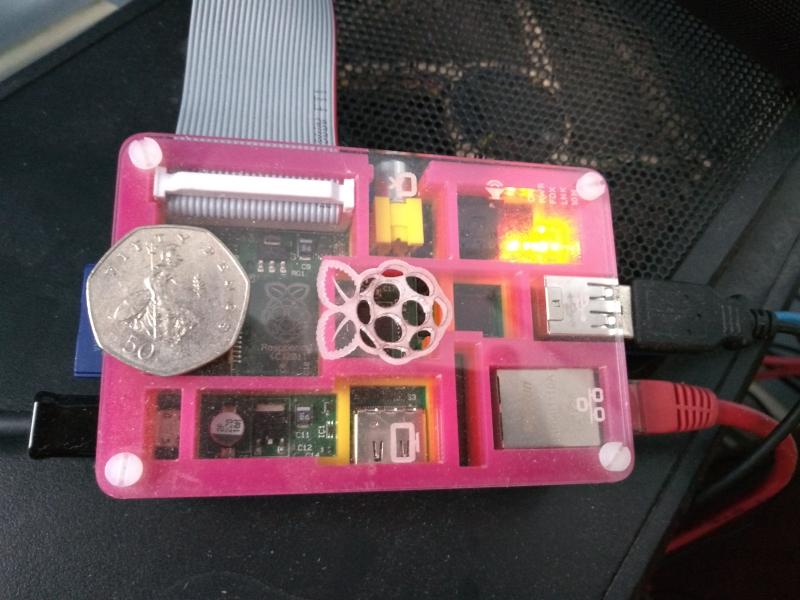Here are my notes on how to build a minimum kernel and root file system for the Pi3.
https://worldofwills.uk/wordpress/Private/Buildroot RPI hints.pdf
Willsy's out and about Wordpress site
Here are my notes on how to build a minimum kernel and root file system for the Pi3.
https://worldofwills.uk/wordpress/Private/Buildroot RPI hints.pdf
I’ve wanted to sort out our home printing set-up for some time. We have a Canon printer which is connected via a USB cable to our desktop PC so whenever we want to print from the Mac we have to boot up the desktop. Our printer is not a network print server.
I’ve owned a RaspberryPi model ‘B’ since they were first sold, but had done precious little with it. It’s too low powered to be used as a real desktop and to use it so I would have to have another screen, mouse etc.
There is a really useful toolset called ‘Buildroot’ which allows a user on a Linux system to cross-compile and build a customised and very small boot image for a very small computer, such as the Pi, so I downloaded the tools and played around to see what it could do.
There are some excellent tutorials on embedded Linux and Buildroot on the free-electrons web site which I pored over for many hours and after some playing managed to configure ‘Buildroot’ to build a dedicated printserver to run on the PI and offer printing to the other computers in our home network. The boot image is less than 150Mb so fits easily on a 256Mb SD card.
The Pi is now powered by the printer so when we switch the printer on, the PI automatically loads up and makes the printer available on our home network.
Here is the PI in its multi-coloured case, note it’s not much bigger than a credit card as can be seen below.

Raspberry PI computers are just brilliant. They retail from just under £10 and run Linux. Using Buildroot, you can create super low cost dedicated devices such as print servers, DNS servers, etc etc that attach to your home wireless networks. Just brilliant!.,
Here is what I did to make it all work:
Then, set up printing from the client computers. The PI printserver uses p910nd to listen on the network for print requests. Clients should access it at: socket://IPADDRESS:9100. To make this all work from the Mac I had to load the Gutenberg Canon printer drivers onto the Mac as the standard Apple Canon drivers do not work across sockets.
Loads of good info on p910 can be found at p910nd
It all works a treat.
Well,it’s time to put Elsie through her first MOT, thereby keeping our chums at DVLA happy. The MOT due date was 2nd October but we thought we’d get it done a few days early to give us time for any remedial work, should any be needed. Oh Ye of little faith…..
Having spoken to the people from Spitfire Garage of Woolston, Southampton, at the Caravan and Camping show in Romsey a few weekends ago, they enticed us by offering a generous 20% discount on the MOT cost, so we booked in for the morning of Tuesday, 26th September.
Finding Spitfire garage was easy enough,in fact we somehow arrived 30 mins early. There was a constant stream of HGVs coming and going, and lots of building work in the vicinity, so we had to carefully choose a parking spot, where we’d cause the least inconvenience- Elsie’s not up to fighting HGVs. After a short but stressful wait parked up, Spitfire were ready to do the MOT.
Fiona and I wandered off into Woolston. Within a few minutes we found Annie’s Cafe on Portsmouth Road and went in for a sit down. Annie’s was a real find; a spotless cafe where a mug of tea and a mug of coffee cost an amazing £1.60. We quite fancied the full English breakfast with toast, being enjoyed by the guy at the next table. That came in at around £4. Maybe next time, we’ll splash out on breakfast.
We returned to Spitfire Garage within the hour to be told that the van had passed its MOT and they were just finishing off the paperwork, and yes, the bill took into account the 20% discount.
All in all, great service from Spitfire and at Annie’s, so we’ll definitely use them both again.
The A3 was also due an MOT in October, however, on her arrival home from work on Thursday evening, Fiona invited me to hear the grinding noise that was coming from the rear end. The off-side rear brake caliper had seized. Bugger! I managed to get it loose by bouncing it over a small kerb, but the car was not really driveable over any distance in its current condition.
A call to Locks Heath garage early on Friday morning had us leaving the car with them for the day during which time they fitted new rear brake discs and pads and replaced the faulty caliper- we were back on the road again by late afternoon. When I collected the car, they offered to take it back on the following morning for its annual MOT, which thankfully it passed.
Next garage job? To sort out some niggles on Fiona’s MX-5. Then maybe decide whether we really need 3 vehicles.